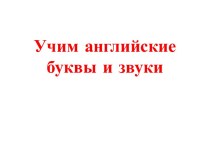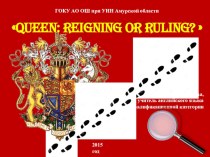- Главная
- Разное
- Бизнес и предпринимательство
- Образование
- Развлечения
- Государство
- Спорт
- Графика
- Культурология
- Еда и кулинария
- Лингвистика
- Религиоведение
- Черчение
- Физкультура
- ИЗО
- Психология
- Социология
- Английский язык
- Астрономия
- Алгебра
- Биология
- География
- Геометрия
- Детские презентации
- Информатика
- История
- Литература
- Маркетинг
- Математика
- Медицина
- Менеджмент
- Музыка
- МХК
- Немецкий язык
- ОБЖ
- Обществознание
- Окружающий мир
- Педагогика
- Русский язык
- Технология
- Физика
- Философия
- Химия
- Шаблоны, картинки для презентаций
- Экология
- Экономика
- Юриспруденция
Что такое findslide.org?
FindSlide.org - это сайт презентаций, докладов, шаблонов в формате PowerPoint.
Обратная связь
Email: Нажмите что бы посмотреть
Презентация на тему Футбол
Содержание
- 2. FootballFootball refers to a number of sports
- 3. Various forms of football can be identified
- 5. HistoryThe Ancient Greeks and Romans are known
- 6. According to FIFA the competitive game cuju
- 7. During the Han Dynasty (206 BC–220 AD), cuju games
- 8. The Japanese version of cuju is kemari
- 9. There are a number of references to
- 10. On the Australian continent several tribes of
- 11. The Māori in New Zealand played a
- 12. Football AssociationDuring the early 1860s, there were
- 13. At the Freemasons' Tavern, Great Queen Street,
- 14. IX. A player shall be entitled to
- 15. At the fifth meeting it was proposed
- 16. Скачать презентацию
- 17. Похожие презентации
FootballFootball refers to a number of sports that involve, to varying degrees, kicking a ball with the foot to score a goal. The most popular of these sports worldwide is association football, more commonly known as
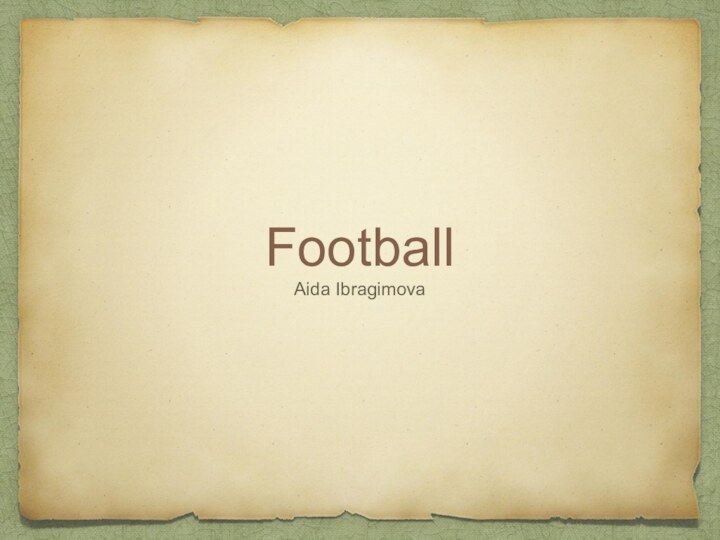

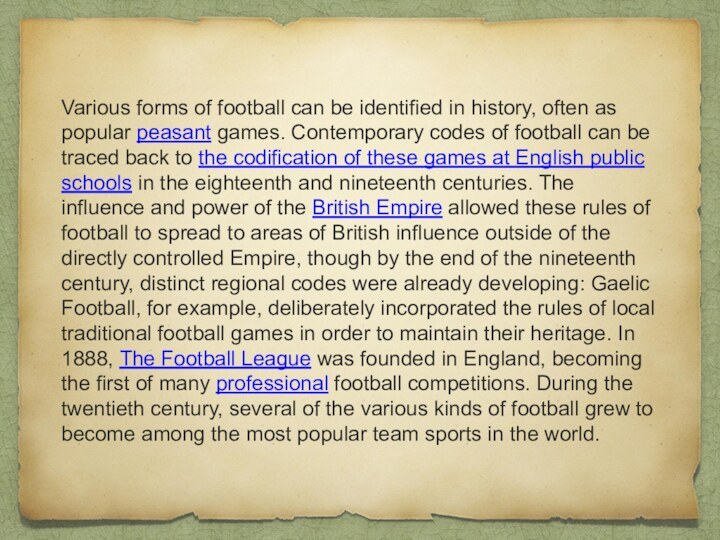
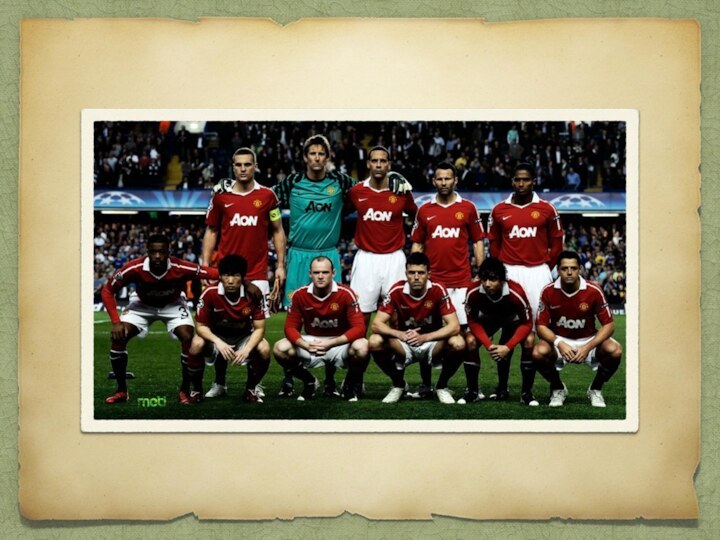

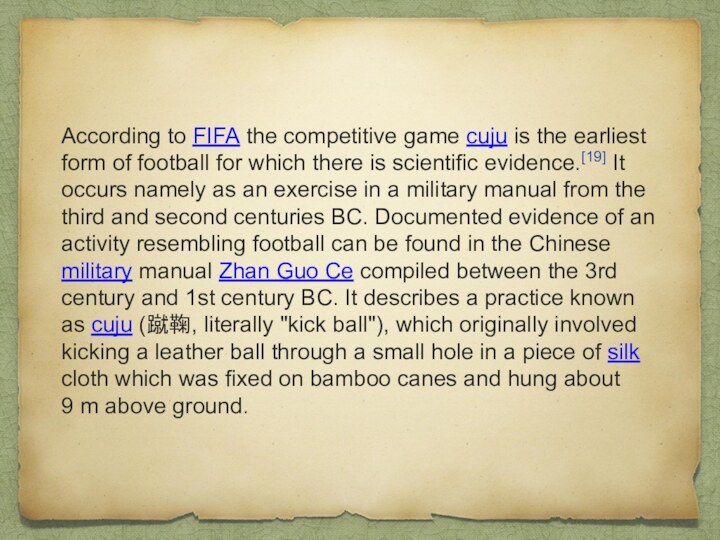
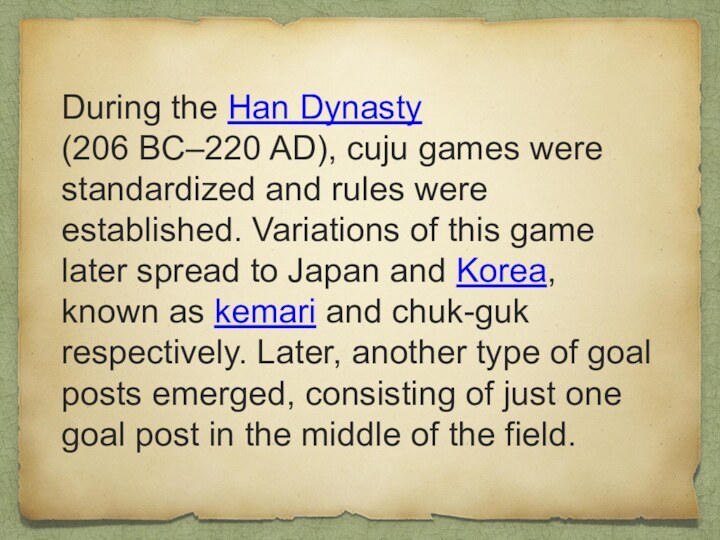


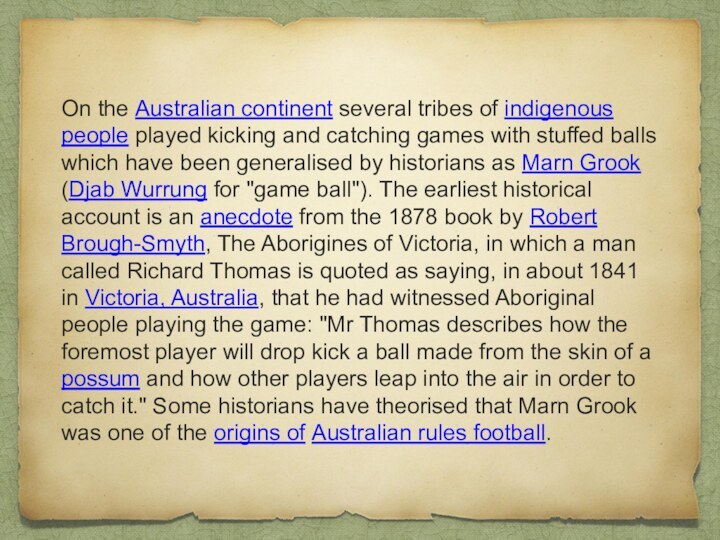
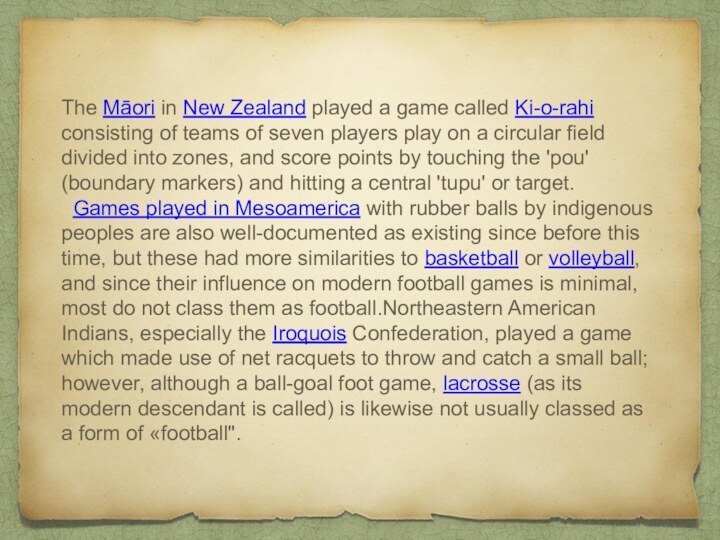
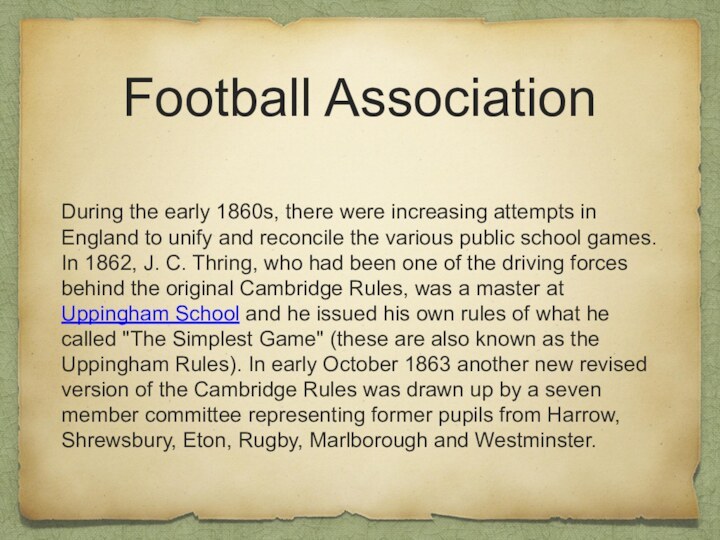
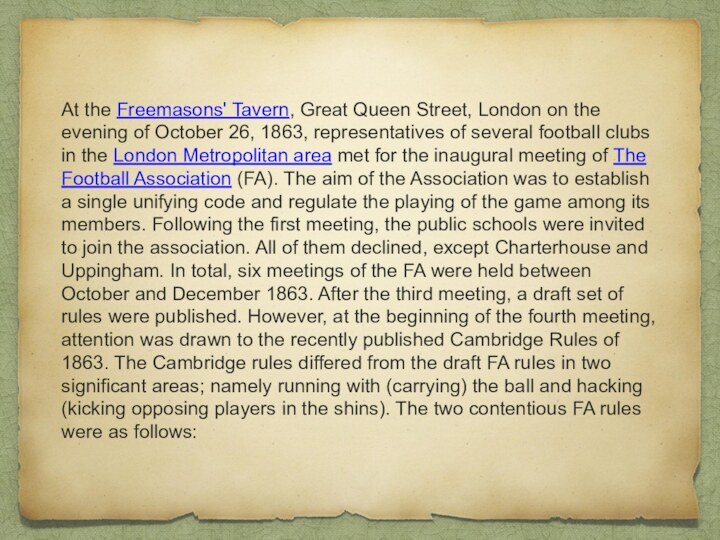
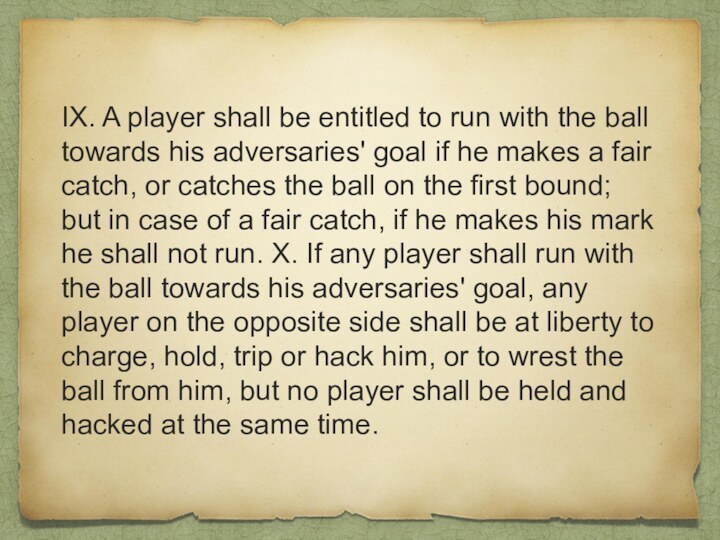
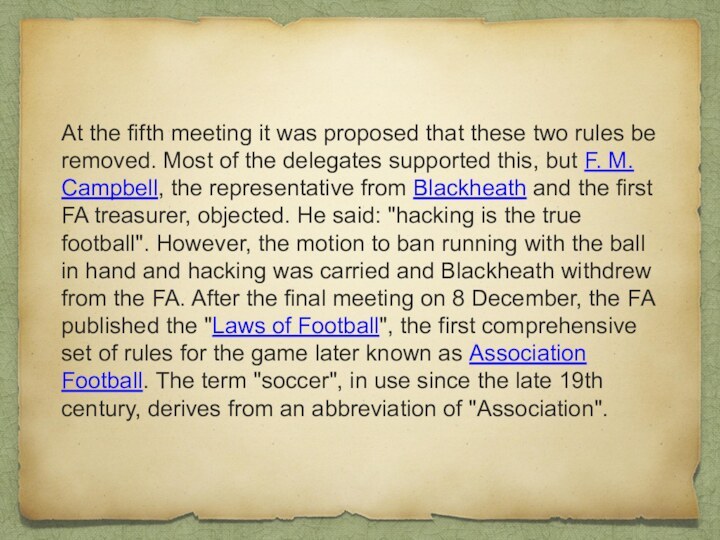

Слайд 3 Various forms of football can be identified in
history, often as popular peasant games. Contemporary codes of
football can be traced back to the codification of these games at English public schools in the eighteenth and nineteenth centuries. The influence and power of the British Empire allowed these rules of football to spread to areas of British influence outside of the directly controlled Empire, though by the end of the nineteenth century, distinct regional codes were already developing: Gaelic Football, for example, deliberately incorporated the rules of local traditional football games in order to maintain their heritage. In 1888, The Football League was founded in England, becoming the first of many professional football competitions. During the twentieth century, several of the various kinds of football grew to become among the most popular team sports in the world.
Слайд 5
History
The Ancient Greeks and Romans are known to
have played many ball games, some of which involved
the use of the feet. The Roman game harpastum is believed to have been adapted from a Greek team game known as "ἐπίσκυρος" (Episkyros) or "φαινίνδα" (phaininda), which is mentioned by a Greek playwright, Antiphanes (388–311 BC) and later referred to by the Christian theologian Clement of Alexandria (c.150-c.215 AD). These games appear to have resembled rugby football.[11][12][13][14][15] The Roman politician Cicero (106–43 BC) describes the case of a man who was killed whilst having a shave when a ball was kicked into a barber's shop. Roman ball games already knew the air-filled ball, the follis. The Ancient Greek game of Episkyros recognised as an early form of football by FIFA.Слайд 6 According to FIFA the competitive game cuju is
the earliest form of football for which there is
scientific evidence.[19] It occurs namely as an exercise in a military manual from the third and second centuries BC. Documented evidence of an activity resembling football can be found in the Chinese military manual Zhan Guo Ce compiled between the 3rd century and 1st century BC. It describes a practice known as cuju (蹴鞠, literally "kick ball"), which originally involved kicking a leather ball through a small hole in a piece of silk cloth which was fixed on bamboo canes and hung about 9 m above ground.Слайд 7 During the Han Dynasty (206 BC–220 AD), cuju games were
standardized and rules were established. Variations of this game
later spread to Japan and Korea, known as kemari and chuk-guk respectively. Later, another type of goal posts emerged, consisting of just one goal post in the middle of the field.Слайд 8 The Japanese version of cuju is kemari (蹴鞠),
and was developed during the Asuka period.This is known
to have been played within the Japanese imperial court in Kyoto from about 600 AD. In kemari several people stand in a circle and kick a ball to each other, trying not to let the ball drop to the ground (much like keepie uppie). The game appears to have died out sometime before the mid-19th century. It was revived in 1903 and is now played at a number of festivals.Слайд 9 There are a number of references to traditional,
ancient, or prehistoric ball games, played by indigenous peoples
in many different parts of the world. For example, in 1586, men from a ship commanded by an English explorer named John Davis, went ashore to play a form of football with Inuit (Eskimo) people in Greenland. There are later accounts of an Inuit game played on ice, called Aqsaqtuk. Each match began with two teams facing each other in parallel lines, before attempting to kick the ball through each other team's line and then at a goal. In 1610, William Strachey, a colonist at Jamestown, Virginia recorded a game played by Native Americans, called Pahsaheman.Слайд 10 On the Australian continent several tribes of indigenous
people played kicking and catching games with stuffed balls
which have been generalised by historians as Marn Grook (Djab Wurrung for "game ball"). The earliest historical account is an anecdote from the 1878 book by Robert Brough-Smyth, The Aborigines of Victoria, in which a man called Richard Thomas is quoted as saying, in about 1841 in Victoria, Australia, that he had witnessed Aboriginal people playing the game: "Mr Thomas describes how the foremost player will drop kick a ball made from the skin of a possum and how other players leap into the air in order to catch it." Some historians have theorised that Marn Grook was one of the origins of Australian rules football.Слайд 11 The Māori in New Zealand played a game
called Ki-o-rahi consisting of teams of seven players play
on a circular field divided into zones, and score points by touching the 'pou' (boundary markers) and hitting a central 'tupu' or target.Games played in Mesoamerica with rubber balls by indigenous peoples are also well-documented as existing since before this time, but these had more similarities to basketball or volleyball, and since their influence on modern football games is minimal, most do not class them as football.Northeastern American Indians, especially the Iroquois Confederation, played a game which made use of net racquets to throw and catch a small ball; however, although a ball-goal foot game, lacrosse (as its modern descendant is called) is likewise not usually classed as a form of «football".


